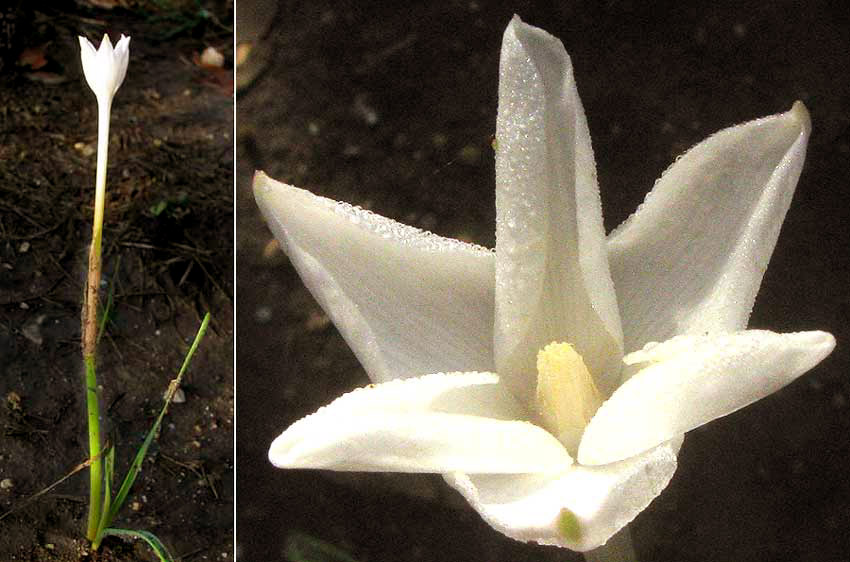Excerpts from Jim Conrad's
Naturalist Newsletter

from the the September 23, 2012 Newsletter issued from the valley of the Dry Frio River in northern Uvalde County, southwestern Texas, on the southern border of the Edwards Plateau; elevation ~1750m (~5750 ft); N29.62°, W99.86°; USA
RAIN LILY
Tuesday at dawn outside the bathroom window there were some white flowers that hadn't been there the previous day. In fact, I was pretty sure that two or three days earlier not even a sprout had been there, for this was naked soil over the septic tank, and I'd have noticed it. That's it above.
The little herb stood only eight inches tall (20cm) and the single blossom spread only about an inch across (2.5cm). It's unusual to see such a relatively large blossom on such a small body.
This is one of several plants called Rain Lily. It's ZEPHYRANTHES CHLOROSOLEN, in older literature listed as Cooperia drummondii, Cooperia chlorosolen and by other names. The rain part of its name makes sense because last weekend we enjoyed a three-inch rain here after a long dry spell. Rain Lilies arise from subterranean bulbs that wait to sprout until there's a good drenching. I only had three plants but a neighbor's lawn for two or three days was white with them, literally thousands prettily swaying in the wind. I read that Rain Lily flowers open only at night but mine stayed open around the clock. As you might expect of a night-blooming, white flower, its fragrance is intense. One field guide describes its odor as variable. To me it smells like a strong perfumed talc trying to smell like lilac.
In our area there's another fairly common, closely related and very similar Rain Lily, Zephyranthes drummondii, but that species is larger and its three-lobed stigma is well included within the corolla tube, while our present species' stigma isn't lobed and it extends beyond the corolla tube's opening.
Some books place Rain Lilies in the Amaryllis Family, but it seems that with genetic sequencing some experts have decided that there's no real difference between the Amaryllis and Lily Families, so newer guides often place them in the Lily Family. Though such an abundantly-occurring bulb-producing plant would seem a likely source of food if it were edible, I can find no reference to its being either edible or inedible.
Rain Lilies are native to Mexico and the US south-central states, from New Mexico to Alabama, though I've never seen them in Mississippi.